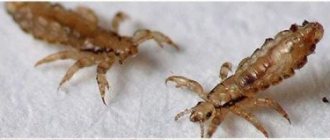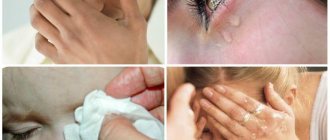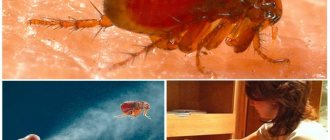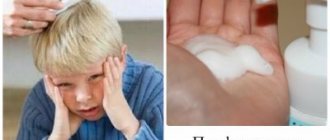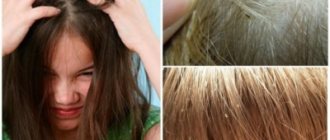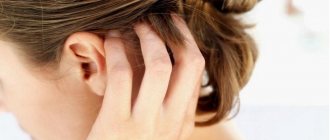Treatment of lice - lice treatment. How to properly treat your hair.
Ectoparasites - parasites that live on the surface of the body of other animals - are a fairly common phenomenon in nature. That's why we encounter it so often in our daily lives.
Pets - dogs and cats - bring fleas on themselves (from the grass, from basements, from other animals), and people, especially children (in schools, kindergartens, camps), often become victims of lice.
We know enough about lice infestation - pediculosis - but sometimes we confuse some facts from the life of lice and fleas due to the similarity of their parasitic lifestyle. To set the record straight, we've put together a little chart outlining the main differences between these insect species.
Louse
Flea
| Head/body lice | Cat/dog fleas | |
| Where live? | Scalp, things, underwear. They don't live on animals. | In the fur of animals, in bedding, in floor cracks. They don't live on humans. |
| How are they distributed? | They crawl from one owner to another, from things or from water, and cannot jump. | They actively crawl or jump over. |
| How do they eat? | They feed on human blood by biting through the skin. | They feed on the blood of animals by biting through the skin. Sometimes they attack a person. |
| How do they reproduce? | They lay eggs (nits), firmly attaching them to the hair. Body lice lay eggs in the seams and folds of linen. | They lay eggs in different places without attaching to anything. This contributes to the widespread distribution of insects. |
| What diseases do humans suffer from? | Typhus and relapsing fever. | Plague, leptospirosis, tularemia, etc. |
| What are the symptoms of infection? | Constant itching, possibly an allergic rash. | Constant itching, dermatitis in dogs and cats. |
Features of the human flea
Pulex irritans is a fairly large human flea, measuring approximately 3 mm in length. Like its relatives, it has good jumping ability, covering distances of up to half a meter. Bloodsuckers move freely in human hair, but they cannot stay there for long. Human fleas have the following characteristic features:
- flattened body, making them difficult to crush;
- the presence of multiple hooks and hairs located on the body and limbs;
- body color from brown to black-brown;
- lack of wings.
Human flea
An adult lives on average for several months, but theoretically the insect's lifespan can be calculated at 500 days. During this time, the female is able to lay up to five hundred eggs. The human flea in the photo posted on the site will allow you to visually get acquainted with the dangerous parasite. They look practically like other species. Only professional entomologists can distinguish this species from its relatives using a microscope. Human parasites may look like small brown grains. Thanks to natural selection, fleas on humans have become virtually invulnerable. Therefore, they do not care that their bites are painless, but bite deeply into the skin of their victim, causing pain.
Blood-sucking human parasites spend most of their lives in secluded places near their prey. Here they lay eggs, from which worm-like larvae emerge, feeding on rotting organic matter or the excrement of adult fleas. When hungry, human fleas attack people or nearby animals and feed on their blood. After being bitten, they immediately leave the body of their owner.
Products for removing parasites
Products intended to get rid of parasites must meet several important criteria:
- maximum efficiency;
- safety for humans and animals;
- lack of resistance to the drug in parasites;
- comfort in use.
This applies to both lice and flea products.
The recognized leader among anti-pediculosis drugs is the drug Para Plus, developed by the French pharmaceutical company.
Para Plus includes three components, each of which has a paralytic effect on the nervous system of parasites, mutually reinforcing each other's actions. The active ingredients of Para Plus are safe for humans.
Para Plus is available in a convenient aerosol form.
When treating the head, the spray is sprayed evenly onto the skin and along the entire length of the hair. After applying the drug, you must wait 10 minutes and then rinse your hair thoroughly with shampoo.
After this procedure, the dead adults are washed out, but most of the dead nits remain on the hair, so after washing your hair they must be combed out with a fine comb. In case of severe infection, it is advisable to repeat the treatment after a week.
When using Para Plus, you may experience a slight tingling or burning sensation at the application site. This feeling goes away after washing your hair.
Para Plus is very economical: one bottle is enough to treat 2-3 people (for treating a patient and for preventive treatment of all members of his family). Please note that in case of severe infection, it is advisable to repeat the procedure.
When treating head lice, it is simultaneously necessary to carry out preventive treatment of linen, textiles and furniture with A-Par.
To treat pets against fleas, there is a large selection of medications in the form of shampoos, aerosols, drops, flea collars, etc. At any pet store, salespeople will advise and help you make the best choice of medication for your pet. It is very important to remember that only 10% of fleas live in an animal’s fur - the rest of the parasite population nests in bedding, carpets, etc., so treating textiles, furniture, floors, etc. when getting rid of fleas is mandatory!
How to treat a child’s head if you find a flea in your hair? Maybe she just jumped over, there was contact with a street cat.
Let's start with the fact that humans don't have fleas; perhaps you saw a lice, not a flea. Some people simply mistakenly call lice fleas.
So, if you find a suspicious scabies on the child’s scalp, I advise you to first examine the child’s head for nits, from which lice hatch. If you find anything suspicious, you can begin processing.
I won’t describe my grandmother’s manipulations with kerosene here. I'll write about the medicine.
One day my nephew came from a children's summer camp and brought back lice. So, Para Plus helped him. The product is relatively inexpensive, literally use it several times according to the instructions, and you will forget about the lice, as if they never existed.
Prevention is better than cure
- It is important to eliminate fleas from pets, as they spread parasites throughout the apartment. Anti-flea collars in combination with sprays or shampoos usually quickly rid your pet of parasites. However, most parents are concerned that these products are toxic to both pets and children. In this regard, it is worth consulting with your veterinarian regarding the safe treatment of fleas on pets.
- Secondly, to avoid flea bites in children, it is advisable to prevent pets from coming into contact with the child's bed.
- Change and wash bed linen regularly in hot water.
- Clothing repellents contain permethrin, which repels ticks and insects, including fleas. When going out into nature with your family, treat your clothes, shoes, hats, and sleeping bags with repellent. At home, mattresses, sofas and other upholstered furniture can be treated with this product.
- In the event of a severe infestation, use a professional flea control service to remove both biting adults and flea eggs and larvae from the home.
Homemade shampoos
Fleas in the hair and on the human body appear from pets: there they love to live in the fur and, if there are a lot of them, they pass on to their owners. In this case, it is better to immediately start using special shampoos to prevent insects from multiplying in large numbers.
- guarantee the death of parasites;
- contribute to the rapid washing out of larvae and dead fleas;
- make living conditions unsuitable for survival;
- relieve itching, inflammation, have a healing effect on wounds - sites of insect bites.
Many people mistakenly believe that just washing your hair more often will make the problem go away on its own. Do not forget: no ordinary shampoo will bring such an effect, and certainly not an assistant in removing flea eggs, which can remain viable for a very long time. Let's consider which flea shampoos are best to choose to quickly destroy parasites.
Today, not only herbs, but also essential oils have shown high effectiveness. The most effective oils are celandine, lavender, cypress, eucalyptus and tea tree: they can be easily added to your favorite hair (and body) wash and washed thoroughly. Oils are safe even for children, of course, if they are not allergic to plants.
When choosing a method of fighting parasites, you should understand: traditional methods still require long-term use, but pharmaceutical preparations relieve itching and expel fleas in a couple of uses. For prevention, wash your animals more often after walks, choosing high-quality care products: after all, animals remain the main carriers, and they need to be monitored.
How to treat
Fleas in a child's head must be removed promptly. It is recommended to treat wounds with antiseptics. Antihistamines will also help. But that's not all. To effectively eliminate itching, you need to anoint the pimples with special ointments, which, in addition, promote rapid healing of wounds. Recognized folk methods also cope well with itching. For example, add a teaspoon of baking soda and ammonia to a glass of warm water. With the resulting composition you can safely treat the bite sites. Knowing what to apply to flea bites, you can quickly relieve discomfort and itching in your baby.
Appearance of lice
To understand what you have to deal with, you need to understand what lice look like on a child’s head. Insects have an unsightly appearance:
- the length of the oblong body of males does not exceed 3 mm, females are larger and can grow up to 4 mm;
- the chitinous cover is transparent;
- the colors of lice depend on the state of satiety: the color of a hungry individual is grayish, after saturation it becomes red;
- 3 pairs of tenacious legs equipped with hooks allow the insect to quickly move through dry hair and cover a distance of up to 20 cm in a minute; hooks help the parasite to stay on wet hair, so simply washing your hair will not help get rid of head lice.
Photos of lice in children's hair clearly demonstrate the appearance of blood-sucking insects. Parasites are localized only in the child’s hair, the most favorite habitats are: the temporal zone, the back of the head, and behind the ears.
Adult lice live 30-45 days. After mating, the female lays 4-5 eggs daily. The fertility of each female reaches 200 eggs. Nits in children are located at a distance of 2-3 cm from the hair follicle.
Embryonic development does not last long - approximately 6-7 days, after which the young individual leaves the capsule, which remains hanging by a hair. The newborn larva immediately begins parasitizing.
Adults feed from 2 to 4 times a day, while nymphs need increased nutrition and eat up to 8 times. Under favorable conditions, having undergone three molts, after 6-8 days the larvae become sexually mature individuals.
Considering the rate of lice reproduction, according to experts, it is enough for two individuals of different sexes or a fertilized female to get on the scalp of a child, and after a month there will be one parasite for every centimeter of area.
Popular means
Medicinal flea shampoo often contains an extract of celandine - a natural poison for many parasites, but especially for fleas (see Celandine for hair). There is an opinion that imported products are produced with new formulas that work faster. This is not always the case - there are also Russian drugs that can quickly cope with parasites.
The list of the best shampoos includes:
- Veda. Antiparasitic Veda is designed to kill fleas, lice, body mites, pubic lice and nits. The action is based on the fact that the active substance, celandine, enters the membranes of the nerve endings of the parasites, which leads to complete paralysis of the insects. The therapeutic effect occurs after 2 weeks, although in some cases the result can take up to 6 weeks. To consolidate the result, the manufacturer recommends using a special cream.
- Lugovoy. At a minimal cost (100 rubles), the product is famous for its high efficiency, and is widely used not only to combat fleas, but also lice. The drug quickly relieves inflammation, degreases the scalp, and heals minor wounds. It acts delicately, having only a slight effect on the delicate mucous membranes of the nose, eyes, and mouth. For this reason, experts allow it to be used even by children.
- Phytoelite. In addition to celandine, the composition contains wormwood and coconut oil, so the drug not only expels parasites, but also strengthens the hair. The color of the shampoo varies from yellowish to greenish, the smell is specific, bitterish-herbal. The peculiarity of the product is that it is always mixed with water before use. It is better for children to refrain from using Phytoelite.
- Celandine Junior. A special product for children with a “no tears” formula. The gentle formula based on celandine is equally suitable for small children and animals that do not tolerate the bathing process well, which increases the risk of shampoo getting into the eyes. The instructions state that the product can expel ticks, so you can try treating animals with it immediately after a walk outside the city.
Signs of the presence of lice in hair
The condition of lice in medical circles is called pediculosis. In the first days of infection, lice in children practically do not reveal their presence and detection of parasites is difficult. A few bites do not cause much discomfort. When the population increases, the following symptoms of lice in children appear:
- severe itching caused by the introduction of an enzyme with the saliva of the parasite that prevents blood clotting;
- fresh lice bites present as red blisters;
- bluish spots may appear, which is due to the characteristics of the child’s body and the manifestation of an allergic reaction to insect saliva;
- enlarged lymph nodes in the neck;
- the appearance of yellow crusts, purulent wounds, tangles in the hair - such signs are caused by a secondary infection when scratching bite sites;
- with prolonged infection, the hair emits an unpleasant odor;
- In children with weakened immune systems, body temperature may rise and a febrile state may occur.
A photo of head lice in children shows all the symptoms.
Symptoms of flea bites
A flea bite on a child can be confused with the consequences of an attack by other blood-sucking insects, but according to some features and symptoms they can be accurately identified:
- flea bites cause severe itching and are painful for young children;
- due to the baby’s delicate skin, lumps and bumps may form in the bitten area, inside which subcutaneous hemorrhage is possible;
- flea bites look like tracks of several wounds;
- a large number of bite marks occur on those parts of the body where there is no clothing: legs, ankles, lower back, because fleas are not able to crawl under the fabric;
- In addition to spots, a rash similar to hives often appears on the body, which is a symptom of an allergic reaction.
Knowing exactly what flea bites look like in children, parents should as soon as possible discover the source of their settlement and take measures to destroy the parasites.
Rules of application
Fleas in a person's head die very quickly if you apply and wash off the product correctly and do not forget about precautions. It is worth taking note of the following recommendations:
- Up to 60 ml of the drug is usually consumed per person’s head, depending on the length and thickness of the strands.
- All drugs are applied either with a cotton swab or with special gloves: it is strictly forbidden to take them with bare hands. First, the product is applied to some base, and then carefully distributed over the entire head.
- After application, the head is covered with a plastic cap and wrapped with a towel on top.
- If shampoo accidentally gets into your eyes, rinse them immediately with plenty of water.
- All products should be used with open windows and, if possible, in an open space: this way there will be no risk of poisoning with toxic substances, which are one way or another included in all medicinal preparations.
- After washing, it is important to comb thoroughly with a fine lice comb.
Where do fleas on a person's head come from?
There are several ways parasites can enter:
- fleas rise from basements, attics, abandoned premises;
- move with stray animals;
- jumping off other people.
According to statistics, the risk group consists of people who live on the first and last floors, which requires them to prevent the appearance of parasites and more carefully monitor themselves and their home.
Usually fleas attack in squads, so if multiple bites appear on the body, then you should immediately begin measures to eliminate the parasites.
Diagnosis of head lice
How to understand that a child has lice can be determined by his changed behavior. If parents notice that their son or daughter is constantly scratching his head, sleeps restlessly, complains of lack of appetite and has become less attentive, it is necessary to examine his head for the presence of parasites.
You can identify lice yourself without resorting to the help of a dermatologist. It is recommended to examine the hair and skin in a well-lit place. To see small nimble lice, it is better to use a magnifying glass.
A neon spray from the Nit Free brand, specially developed for this purpose, will help determine whether a child has lice and nits. For dark hair, white is used, and for light hair, pink. Sprays contain luminescent paint that illuminates nits, thereby facilitating their identification and subsequent combing out.
Often on forums, frightened parents write that white lice have been found in the head of their beloved child. This color is not associated with a separate type of parasite, but only indicates that this is a newborn individual, the chitinous cover of which has not yet fully formed and has not taken on the color characteristic of lice.
It is quite simple to distinguish that it is lice that are parasitizing on a child, and not attacking other blood-sucking insects:
- bites of head parasites are always located on the skin of the head; lice are not adapted to exist on other parts of the body;
- In addition to the head louse, a closely related morphological species, the body louse, can parasitize the human body. Representatives of this species live in the folds of clothing and appear on the body solely to replenish nutrients. Linen lice bites are located on the body, but they can never be found on the head;
- bed bugs, fleas leave their “marks” on the legs, stomach, arms, and after a meal they leave the food item;
- A head louse can unknowingly be confused with a tick, but the latter has 8 legs, while a louse has only 6.
What infections can fleas carry?
Parasite bites threaten not only with redness, unbearable itching and blisters. Insects are often carriers of many dangerous diseases. This does not mean that every individual is infected, but the risk is quite high.
If fleas appear in a child’s head, this can lead to the development of the following pathologies:
- hepatitis;
- brucellosis;
- anthrax;
- tularemia;
- encephalitis;
- salmonellosis.
With a single bite, you can protect your baby from infection. But if a whole population of fleas has settled in an apartment, it will be difficult to prevent the development of serious diseases.
How does infection occur?
Ways of lice infection
Despite the fact that anyone can become infected with lice, regardless of age, social status and financial situation, children and adolescents are most often exposed to lice infestation. There are several ways where lice come from:
- Visiting preschool and school institutions. Children are constantly at close range and direct contact with hair occurs often: during games, sitting at the same desk. It only takes one infected person to appear in a group for an epidemic to begin.
- School locker rooms can also lead to lice infestations. If adults are wearing a headdress, it will not be difficult for them to crawl into the next hat.
- The possibility of “picking up” lice in crowded public transport is not excluded, where the parasite can literally migrate “over the heads”.
- Wearing contaminated hats, using other people's combs, hair clips.
- Visiting a hairdresser who is negligent in handling tools.
- Swimming in open waters or pools without a protective cap.
Lice do not appear after a child comes into contact with pets or stray animals. They belong to parasites of narrow specialization and each species of warm-blooded animals has its own variety of lice eaters.
How to prevent subsequent infection
To prevent the recurrence of parasites, pets should be treated. Pets are put on special collars or their fur is treated with anti-flea drops. A cat or dog should not be constantly with the child or have access to his bed. Children should be prohibited from contacting stray animals. They often turn out to be flea-bearing and can even infect a person using special ointments.
You should regularly comb your child's hair using a fine-toothed comb. If adult insects or their larvae are found between the teeth, treatment should be started as quickly as possible. In the early stages, it is easier to get rid of parasites. It is better to treat all family members and the child’s friends at once in order to completely get rid of insects.
Source
How to get rid of lice
If you find lice on a child, you must immediately begin exterminating them. Pediculosis is recognized as a disease and, like all ailments, requires treatment. However, society’s stereotypes are such that many are ashamed of their children’s lice and carry out therapy at home without disclosing the diagnosis.
Therapy for pediculosis in children
The fastest and most painless way to remove blood-sucking fauna is to cut the hair to zero. However, this method is acceptable for little kids or boys who want to add brutal and aggressive notes to their image.
Most people, for aesthetic reasons, do not want to part with their hair, and children are no exception. Thanks to the huge arsenal of pediculicides, such a radical measure is not necessary.
To remove lice from children, folk remedies and pharmaceutical preparations are used. The pharmaceutical industry produces creams, ointments, shampoos, sprays, and concentrates, which allows the consumer to choose a convenient form of release.
- The product is applied to damp or dry hair.
- The treated strands are covered with a plastic cap.
- The drug is kept in accordance with the time specified in the instructions.
- The product is washed off with water. In most cases, the hair is additionally rinsed with a vinegar solution or diluted juice with an acidic environment.
- The procedure ends with combing out dead insects and nits. To do this, use a lice comb with frequent steps. Often, a combing accessory is included with the pediculicidal product.
After 7-10 days, the procedure is repeated, since almost all products do not kill nits, and combing cannot give an absolute guarantee that not a single individual remains in the hair.
Traditional methods
Traditional methods of getting rid of lice
However, such substances can cause burns on the child’s delicate skin and damage the hair structure. More gentle means include vinegar, cranberry, pomegranate, which destroy the adhesive substance with which nits are fixed to the hair.
Pharmacy products
Remedies for children against pediculosis
The pharmacy chain offers a wide selection of drugs. The most effective ones that can be used for children:
- Products for children from 6 months are represented by the only drug Nyx. Available in the form of a cream, the consistency of which is similar to shampoo. A bottle costing from 700 rubles is enough for 2 treatments of short hair.
- For children over one year of age, the Nit Free brand offers a large selection of products. Preparations based on natural ingredients and essential oils. Disadvantages: too oily structure, which makes the product difficult to wash off, and high price. Paranit Sensitive liquid is also produced for small babies. The peculiarity of the drug lies in its application. Moisten dry hair with the product until completely moisturized and leave for 6-8 hours.
- Preparations for treating the hair of children over 2 years old. Shampoos: Nok, Pedilin, Sumitrin. Sprays Lavinal, Para Plus (from 2.5 years).
- For three-year-old children, the choice is expanded with Paranit, which contains oils and no chemical components. Like all oily preparations, it is difficult to remove from hair. Nuda spray is also recommended for children of this age category. The advantage of the product is the ease of application to the hair.
- For children over 5 years of age, almost all pharmaceutical pediculicidal products become available. The range is expanding with the following drugs: Hygia, Veda, Pediculen Ultra, Full Marks, Nittifor, Medifox.

